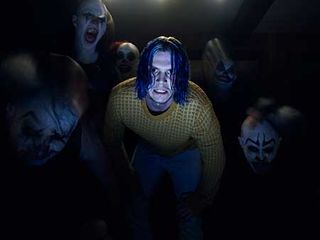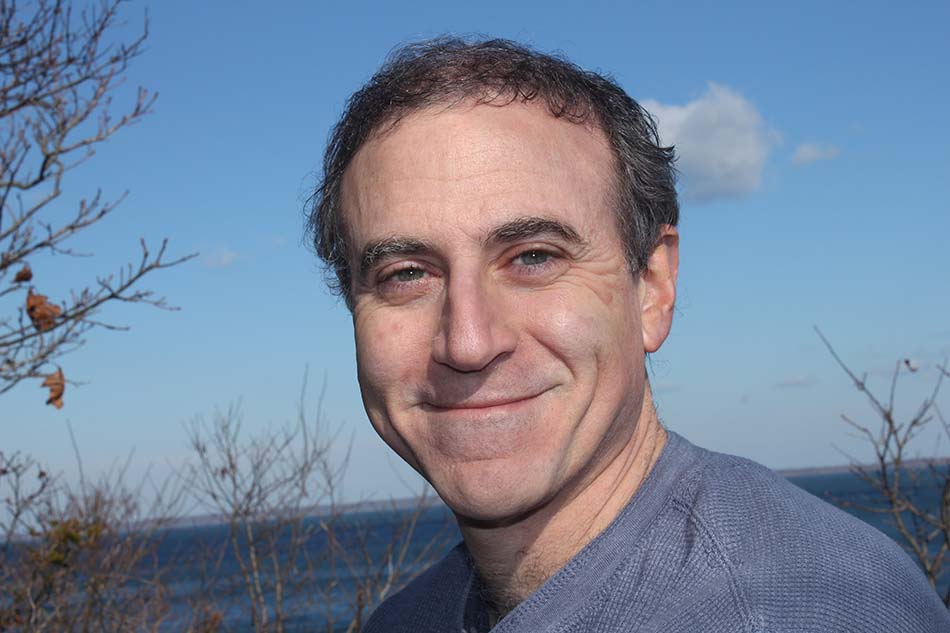What Are We So Afraid of?

On April 26, 2017, America woke up to news of whether national security adviser Michael Flynn was lying about business dealings with Russia, President Donald Trump threatening a federal government shutdown tied to Mexico border-wall funding and the United States moving a controversial missile defense system to South Korea to protect us from North Korea’s burgeoning nuclear threat.
That same evening, the images a wide swath of Americans saw before bed came from the premiere of the Hulu series The Handmaid’s Tale, about a young wife and mother (Elisabeth Moss) captured and separated from her family, and forced to be a part of a dystopian world where women have no rights and are forced to bear children for the country’s leaders. That’s what they watched — and binged — by choice.
The desire to experience the things that will frighten us is a longstanding, profitable phenomenon that goes back to radio. But why does it not abate when life itself is as scary as what we’re watching?
Related: Millennials Troubled by Trump, GOP
In the months since The Handmaid’s Tale premiered, we’ve experienced deadly wildfires, deadly hurricanes, a deadly shooting in Las Vegas, a deadly white supremacist rally in Virginia and antics in Washington that make one’s head spin. And in that time, while Hulu doesn’t publish viewing totals, The Handmaid’s Talewon Outstanding Drama Series at this year’s Emmys, becoming the first streaming series to do so.
The practice of watching stalwart fright-fests when the world feels on shaky ground gets an even greater test now as Halloween spells new seasons of TV’s most popular series, The Walking Dead(which premiered Sun., Oct. 22 on AMC, to 11.4 million viewers), and one of last year’s true breakout hits, Stranger Things, which premiered Oct. 27 on Netflix. (For more on Halloween programming plans, read Digital Platforms Are Feeling the Fear.)
They’re hardly alone: American Horror Story: Cult, running on FX, directly relates to the country’s political climate, and Netflix’s new Mindhunter explores the mind of a serial killer in the 1970s in ways that seems strangely prescient. We’re also still watching the uncomfortably realistic scares on Westworld (HBO) and House of Cards (Netflix), and this in a year when Get Out was the most talked-about film of the summer, and It, Stephen King’s tale of a murderous clown that lives in a gutter, swept up at the box office.
In most cases, there is a strange safety net that comes with experiencing these scares and knowing they’re not real. It’s a feeling even more in demand right now, when a number of Americans are seeking a level of control and a greater degree of hope about the world around them.
“We’re all looking for escape, especially these days,” media consultant Bill Carroll said. “Things are so uncertain; every day there are new issues and television provides that escape. I guess to a degree it’s fiction-scary vs. fact-scary. A lot of things are concerning in everyday life and the circumstances we’re dealing with, but this is a way to deal with that in a safe environment.”
The Fright Stuff
The power of scary content to provoke a reaction, especially at this time of year, hearkens back to media’s most infamous script, Orson Welles’s War of the Worlds radio drama, which took place exactly 79 years ago, on Oct. 30, 1938.
The Mercury Theatre on the Air Halloween episode was so realistic — much of it presented as a series of news bulletins interrupting a radio show — that a number of Americans fled from their homes to escape an attack from Mars.
Its prescience in today’s age is uncanny; with 20/20 hindsight that drama was both the very essence of so-called fake news, and the seed of how word-of-mouth, hearsay and rumor — so prevalent on social media — can inspire a terrifying reaction.
“There’s the suggestion that if only there had been better communication then — but no! People would have just found the rumors faster,” said Walter Podrazik, television curator at the Museum of Broadcast Communications in Chicago and co-author of Watching TV, a book on the history of television. “Social media, and the ability to instantly communicate with someone, now puts the echo chamber effect in.”
The “widespread panic attack” plot line, especially right there on the street where you live, has long been a television staple. One can argue that the famed Twilight Zone episode “The Monsters Are Due on Maple Street” is something of a sequel to Welles’s program, this time with the aliens actually landing and talking about how easy it is to control earthlings.
In a sense, it doesn’t even matter what the evil is or how it came to be; it’s more about how we react, and how the horror reflects the times, much as the original Night of the Living Dead is about as perfect a reflection of the year it came out — 1968 — as any other living document.
And now, in an age of unease where nobody can be entirely sure of anything, other than that all your personal information was probably stolen in the Equifax hack, it’s easy enough to believe danger may be imminent. Somehow that makes watching people just like us go through these situations on a screen large or small both cathartic and instructive.
The enticement of watching horror that “hits too close to home” is certainly part of the reason fans were so eager for last Friday’s return of Stranger Things. Even though 12-year-old Will Byers has returned from the “Upside Down” dimension where he’d been held after meeting up with the Demogorgon monster, all is clearly not well. But the seed of the appeal for fans of big scares comes courtesy of watching Will, his three best friends and their new E.T.-like telekinetic friend, Eleven.
Related: 'Stranger Things' Caps Dramatic Night for Netflix at SAG Awards
In a world where our news feed gives us constant updates on threats of nuclear war, election interference and real-life uncertainty about health care and taxes, there’s a certain odd comfort in watching the most vulnerable among us gain courage and prevail in small-town America — especially when they’re battling evil-minded adults concocting mysterious things in the local laboratory.
“Kids and young teens are usually powerless. They do not control the leaders of government or school, so if they know something, trying to convince the powers that be is infinitely challenging,” Podrazik said. “They’re usually greeted with, ‘Go away, kid; come back when you grow up.’ We look to horror to be reminded of how frightening a situation can be, even in the relative safety of the mall or your own neighborhood — where that safety is a little bit of an illusion.”
Added Carroll: “There’s so much we don’t have control over in the political realm or now in the physical realm with California wildfires, trouble down South, and there’s so much in our environment we have no control over and nothing to do with, and there’s a certain catharsis that can happen in experiencing these scary things but then knowing in the end, in this case, we’re actually safe.”
Living To Tell the ‘Tale’
There are probably some Americans who believe we’re on a path to some dystopian nightmare society a la The Handmaid’s Tale. It’s hard to blame them, one year after the popular rallying cry for many women has tragically shifted from “I’m With Her” to #MeToo. But among the positives of watching June/Offred (Elisabeth Moss, herself an Emmy winner) on the series is her embodiment of courage and the never-lost idea that her single objective, come what may, is to reunite with her husband and her daughter, against a frightening collection of odds.
And while the trappings of the totalitarian Christian Gilead state, established after a fictitious U.S. civil war, may produce an “It could happen!” outcry on Facebook, the truth is, it hasn’t. And so when we watch June make every move possible to ultimately get her wish, as bad as things get, we’re inspired to be following a script on this side of the screen.
“Drama is therapy,” Podrazik said. “It’s an opportunity to help us collectively better articulate what we’re grappling with and that’s one of the things I love about TV. It’s happening right in your personal space and that sometimes makes the fright go a little deeper and lets the opportunity for thoughtful reflection and catharsis play out more.”
‘Dead’ Set on Hope
The Walking Dead, meanwhile, faced a real, unintended conundrum. On Oct. 23, 2016, with Election Day only two weeks away and the country in a state of impossible tension, TV’s most popular series premiered season 7, concluding a cliffhanger in perhaps the most awful, gruesome method possible. The cunning and evil Negan (Jeffrey Dean Morgan) ultimately kills Glenn (Steven Yeun), the moral center of the entire series. And though it garnered 17.03 million viewers, it’s second-highest viewing total ever, the one-two punch of an ugly presidential campaign and an even uglier skull-breaking killing could only be termed a case of overkill.
Related: AMC’s ‘The Walking Dead’ Return Slays Social Media
Did the election results and the malaise and outrage in many quarters that followed somehow contribute to the series posting viewing totals that ultimately slipped to a little more than 10 million per episode? It couldn’t have helped; neither did the plot lines, which showed a kind of shock and hopelessness.
But a funny thing happened on the way to season eight of the series. Rick (Andrew Lincoln) and the forces of Alexandria have gotten their mojo back, fueled by a greater purpose, deeper strategy and, yes, a thirst for revenge that would rival the appetites of the walkers themselves.
And more than that, there’s a return to hope, much like in a country that is a little tired of waiting for something to happen — good or bad — and has resolved to both deal with natural tragedies and get out the vote in some crucial off-year elections. On The Walking Dead, people of very different backgrounds and races are coming together with a sense of purpose to deliver hope. As Rick puts it in the season premiere, “This is our land, by right, and anyone else who would find common ground, it’s their right, too. Keep our faith in each other, and if we can hold onto that, the future is ours; the world is ours.” And that’s something worth watching play out, even while wincing as thousands of walkers clamor for more blood.
“These tales, scary as they might be, demand that individuals rise to the occasion and not only fight off the hordes, but keep their own humanity — as best as they can — while facing off against others who have exploited the situation for their own power grab,” Podrazik said. “Why do we fight? Because that’s what elevates our own personal situations. And if we’re using horror as a departure from everyday life, part of the reason that works is, at least in these situations, there are moments of hope. And individuals can make a difference.”
Multichannel Newsletter
The smarter way to stay on top of the multichannel video marketplace. Sign up below.
Rob has written for Broadcasting+Cable since 2006, starting with his work on the magazine’s award-winning 75th-anniversary issue. He was born a few blocks away from Yankee Stadium … so of course he’s published three books on NASCAR, most notably, Full Throttle: The Life and Fast Times of NASCAR Legend Curtis Turner. He’s currently the special projects editor at TV Guide Magazine. His writing has appeared in The Washington Post and his origami art has been in The Wall Street Journal. He lives with his family in New Jersey and is writing a novel about the Wild West.

